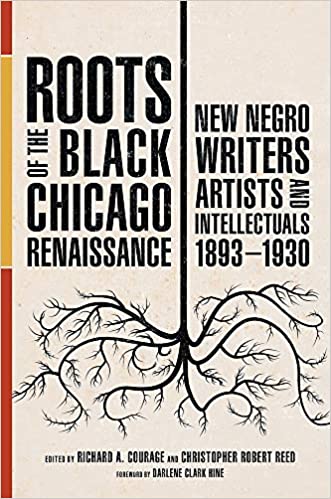The Book
Roots of the Black Chicago Renaissance: New Negro Writers, Artists, and Intellectuals 1893-1930
The Author(s)
Richard A. Courage and Christopher Robert Reed, eds

“There is good reason to retrace the ground a bit and gather up those individuals, texts, sites of production, and events the never quite fit earlier descriptions of the point and counterpoint of New York’s Harlem and Chicago’s South Side.”[i] Roots of the Black Chicago Renaissance attempts to do just that by showing that the wave of social and creative production in the Harlem Renaissance of the 1920s and the Chicago Renaissance of the 1930s was the rule instead of the exception. By recuperating, expanding, and predating these better-known “renaissances” in eleven chapters and three literary pieces, this collection shows 1. that Black creative production was a successful constant of the first half of the twentieth century and 2. that Chicago was foundational to much of it.
After a helpful forward and introduction by Darlene Clark Hine and John McCluskey Jr., respectively, the volume begins with a rich contextual overview by Christopher Robert Reed (chapter 1). The editors organize the book into three sections. The first section of four chapters explores the rehearsal for modernity from 1893 to 1919, with chapters on Frederick Douglass and the World’s Columbian Exposition (chapter 2), Fannie Barrier Williams and Black feminist pragmatism (chapter 3), James David Corrothers and his friendship with Henry Demarest Lloyd (chapter 4), and Fenton Johnson’s literary entrepreneurship (chapter 5). The second section’s five chapters unpack “Chicago’s New Negro” in the 1920s at the onset of modernity, including chapters on Black portraiture (chapter 6), Archibald J. Motely Jr.’s hybrid identity (chapter 7), Black dancers (chapter 8), Richmond Barthé (chapter 9), King Daniel Ganaway (chapter 10), and the Chicago Letters group (chapter 11).
The third section departs from typical edited collections by including literary works. The first piece, by John McCluskey Jr., imagines a meeting held by the men planning Colored American Day at the World’s Columbian Exposition. They debate the proposed acts and events, offering a dramatization of the conflict Black Americans had in this moment about whether to show Black Americans as excelling at classical European works or as creating a new vernacular American culture. The second is an excerpt from Charles S. Johnson’s “These ‘Colored United States’ VII- Illinois: Mecca of the Migrant Mob” from The Messenger, which details his impressions of Chicago as the “Colored capital” due to The Great Migration. The volume ends with a prose poem presumably from Frank Marshall Davis titled “Entering Chicago;” the final line reads “a cosmopolitan aggregation of persons people Chicago flats and no two alike” (258). While the literary pieces add great texture to the volume and offer more personal accounts of Black Chicago, having them interspersed within the scholarly chapter could have been more helpful.
The strength of the collection is its diversity. Chapters explore the life and work of visual artists, politicians, social workers, publishers, writers, dancers, and businesspeople. The book makes the point that Black artists were also entrepreneurs and Black businesspeople were important patrons of the arts in Chicago in this period. The chapters offer a contrast to the monolithic idea of “the New Negro” made famous by Alain Locke in 1925 by showing multiple Black consciousnesses and worldviews. While several chapters explore well-known figures such as Frederick Douglass, Robert S. Abbott, Jesse Binga, Fannie Barrier Williams, and others, other chapters (some of the most interesting in the volume) focus on minor figures, or on major figures who have had little scholarship dedicated to them such as publisher Fenton Johnson dancer and dance teacher Hazel Thompson Davis, and photographer King Daniel Ganaway. Touchstone Chicago events familiar to historians show up in the volume—the world’s fairs (both the Columbian Exposition in 1893 and the Century of Progress in 1933-4), the Negro in Art Week at the Art Institute of Chicago in 1927, and the founding of the George Cleveland Hall library branch in 1932—but the collection also lifts up overlooked moments such as the founding of the first independent Black journal, The Champion in 1916; Hazel Thompson Davis’ dance revues from 1916 to 1923; and the founding of Letters, a Chicago literary group in 1927. The book is wonderfully visual, as well, with some of the most engaging chapters reprinting and analyzing portraits, newspaper advertisements, photographs, and sculptures.
This book will serve history, visual art, performance, literature, urban studies, and Black studies classrooms, and the chapters invite a new generation of scholars to keep digging into the scarcely tapped and rich history of Black Chicago and its influence on US history.
[i] Richard A. Courage and James C Hall, “Fenton Johnson, Literary Entrepreneurship, and the Dynamics of Class and Family,” in Roots of the Black Chicago Renaissance: New Negro Writers, Artists, and Intellectuals 1893-1930, eds. Richard A. Courage and Christopher Robert Reed. (Champaign: University of Illinois Press, 2020), 95.
About the Reviewer
Megan Geigner is Associate Professor of Instruction of the Cook Family Writing Program at Northwestern University. She is the co-editor of Theatre After Empire (Routledge, 2021) and Makeshift Chicago Stages: A Century of Theater and Performance.

0